No, consumers did not suddenly return to the mall. It was just a media joke. They shopped online more than ever. Department store sales have plummeted.
By Wolf Richter for WOLF STREET.
The retail sales data, reported today by the Census Bureau, is based on surveys of about 5,500 retail businesses across the United States, which they told their Sales were. The measure is designed to track the extent to which retailers do by retailer categoryand we’ll get into those categories in a moment.
Another measure follows consumer spending, based on consumer surveys. It is reported separately and is available in an inflation-adjusted version. But not today (here is the “real” consumer spending for June).
Retail sales follow sales of goods, not services, and represent only a portion of consumer spending – and about two-thirds of consumer spending is on services, and spending has shifted back to services throughout the world. ‘year.
These are important distinctions between retail sales and consumer spending. I mention it here because it always seeps into our illustrious comments section below the article.
Retail sales data is designed to examine retailer health by retailer category, not consumer health, although we can draw some conclusions from these retail sales about consumers.
Inflation at retailers = rising prices. But where?
CPI inflation in July was 8.5% compared to July last year. Compared to June, the CPI was stable. But this varied greatly by product category. The CPI for services is soaring unabated but does not show up in retail sales because retailers are selling goods.
Gasoline CPI: -7.7% in July from June; if gas stations were selling the same gallons in July as they did in June, their retail gasoline dollar sales would have fallen 7.7% from June. But they didn’t – they only fell 1.8%, as we’ll see in a moment.
The “food at home” CPI: +1.3% in July from June. This means that if consumers bought the same amount of food and did not switch to cheaper products, grocery store sales could increase by 1.3% for the month. But they didn’t. They only increased by 0.2%, as we will see in a moment.
CPI for durable goods: +0.3% in July compared to June and, after a decline in the previous months, was stable with February. The surge in durable goods prices occurred in 2021 and has now largely stabilized as inflation has shifted towards services. Retailers selling durable goods (not food or gasoline) saw relatively fewer and weaker, if any, price increases in July.
Sales at retailers.
July retail sales of $683 million (seasonally adjusted) were flat from June, but up 10.3% from July last year and 31.6% from July 2019, according to Census Bureau today.
But gasoline prices have plunged, which has reduced gas station dollar sales; and new vehicle dealers were sorely lacking in inventory (down more than 70% compared to 2019, in number of new vehicles), which was hampering their sales. Thus, excluding gas and automobile dealers, retail sales jumped 0.7% in July from June.
Total retail sales:
Retail sales minus sales at gas stations and car dealerships:
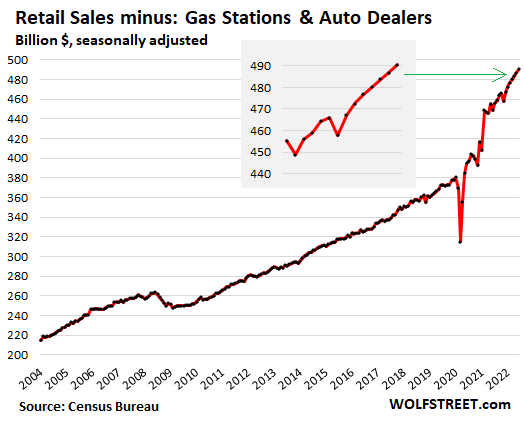
Sales by retailer category.
New and used vehicle and parts dealer sales fell 1.6% in July from June to $125 billion, seasonally adjusted. Compared to July a year ago, sales were still up 2.1%, and compared to July three years ago, they were up 21%. This is the largest retail sales category.
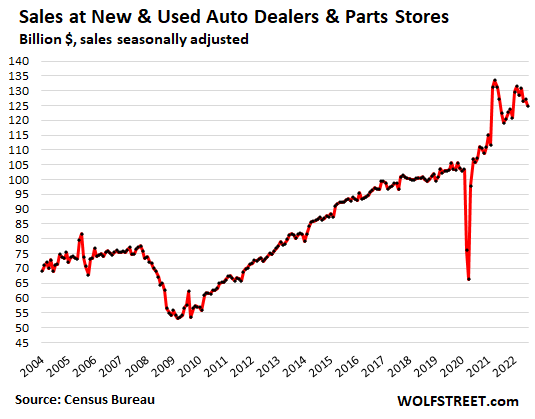
E-commerce sales and other “non-store retailers” rose 2.7% in July from June to a new record high of $111 billion, seasonally adjusted, up 20% year-over-year and 73% from July 2019 as consumers did not suddenly and inexplicably return to the mall – despite silly hype to the contrary. See department store sales below to see how it worked for them.
This includes sales by pure e-commerce retailers and physical retail e-commerce operations, as well as sales at stalls and markets:
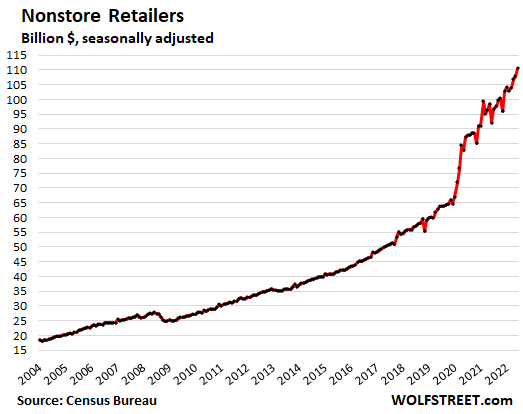
Food and Beverage Stores: Sales rose 0.2% for the month to $79 billion, up 9.2% year-over-year and 22% three-year:
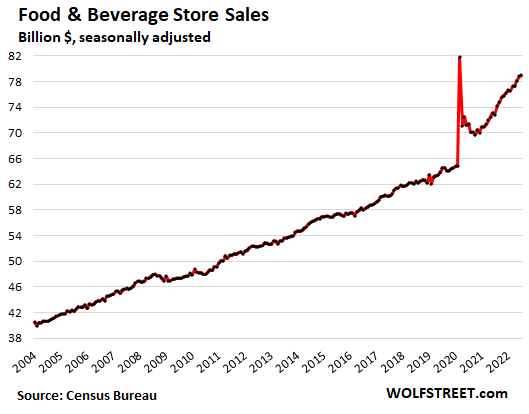
Food services and drinking places: Sales in bars, restaurants, cafes, cafeterias, etc. rose 0.1% for the month to a record $86 billion, up 11.6% year-over-year and 32% three-year.
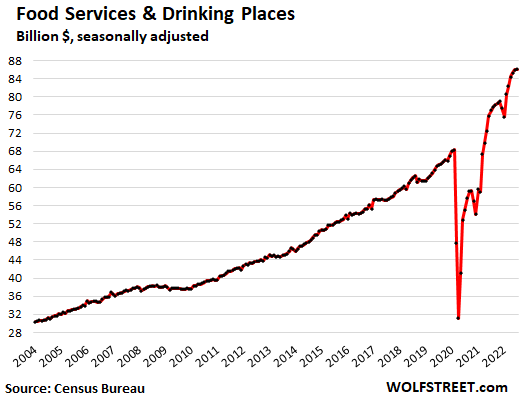
General Merchandise Stores: Sales fell 0.7% for the month, to $56 billion, and were up just 0.9% from last year’s stimulus miracle, and rose 15% over three year. Walmart and Target are in this category, but not department stores:
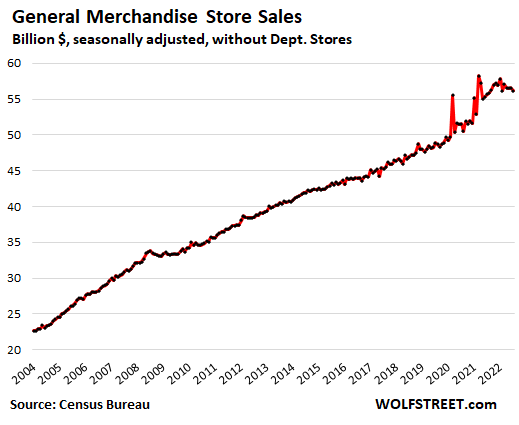
Service stations: Prices plunged in July, yet sales fell just 1.8% from June, seasonally adjusted, to $67 billion, the second highest on record, behind June. This was up 40% from a year ago and 57% from three years ago, as the price spike subsided somewhat:
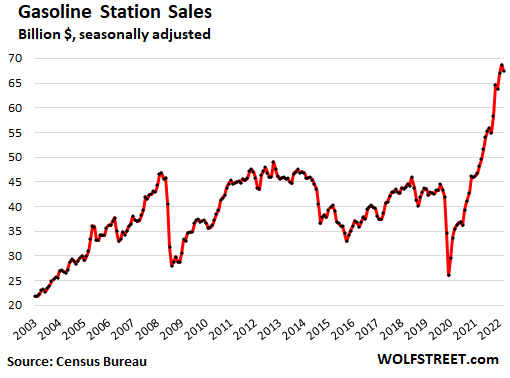
Stores of building materials, supplies and garden equipment: Sales jumped 1.5% to $43 billion, seasonally adjusted, up 10% year-over-year and 37% three-year:
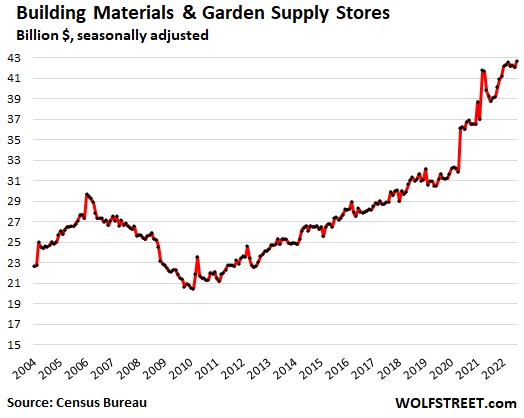
Clothing and accessories stores: Sales fell 0.6% for the month to $26 billion, up 2% year-over-year and 15% three-year.
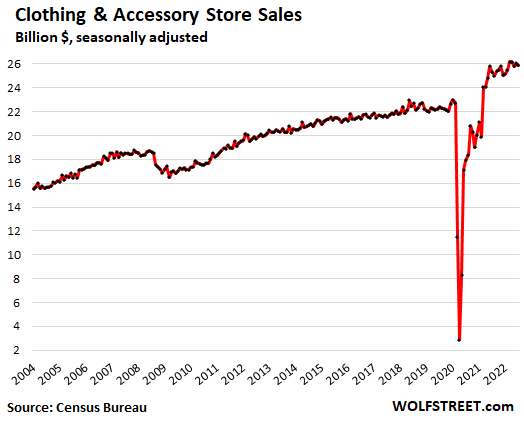
Miscellaneous in-store retailers (including cannabis stores): Sales jumped 1.5% for the month, 18% year-over-year and 50% three-year to $16 billion. This category tracks specialty stores, such as art supply stores, brewing supply stores, etc., and cannabis stores, which are the hottest trend in physical retail:
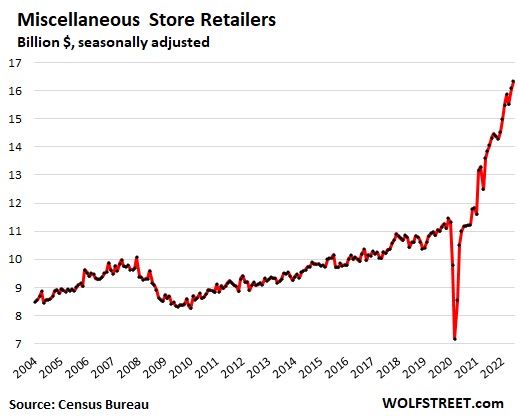
Furniture and home furnishings stores: Sales rose 0.2% for the month to $12 billion, up 2% year-over-year and 20% three-year:
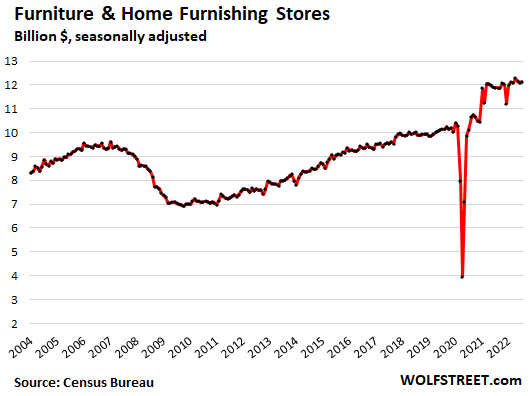
Department stores: sales fell 0.5% for the month, 1.4% year over year and 3.3% year over year to $11 billion. From the peak in 2000, sales have fallen 44% as thousands of stores disappeared amid an endless series of bankruptcies and liquidations as Americans opted to buy their products from department stores on line :
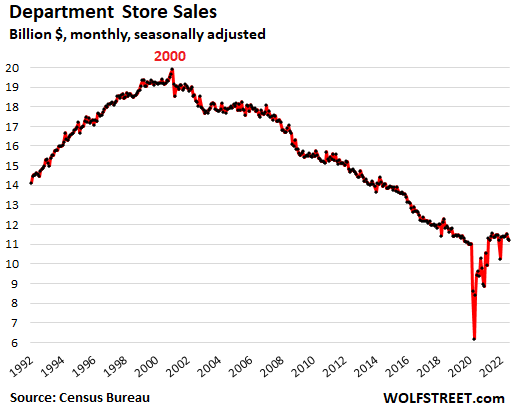
Sporting goods, hobby, book and music stores: Sales rose 0.1% for the month to $9.2 billion, up 4% year-over-year and 38% three-year:
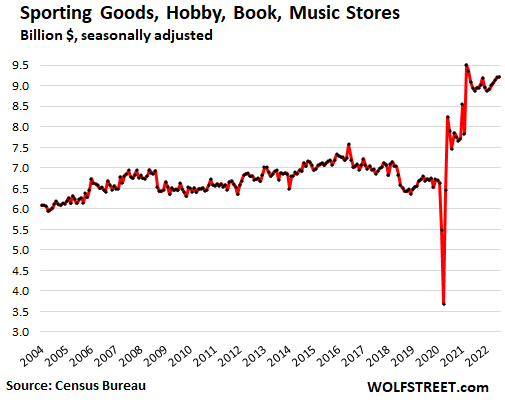
Electronics and appliance stores: Sales rose 0.4% for the month to $7.6 billion, down 10% year-over-year and 1% year-on-year.
This category of retail stores only covers specialty electronics and appliance stores, such as Best Buy’s physical stores or Apple’s physical stores. It does not cover other retailers that sell electronics and appliances, such as Walmart, and it does not cover online sales of electronics and appliances:
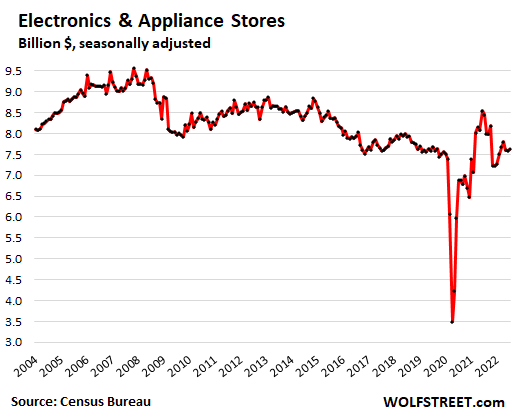
Do you like to read WOLF STREET and want to support it? You use ad blockers – I completely understand why – but you want to support the site? You can donate. I greatly appreciate it. Click on the mug of beer and iced tea to find out how:

Would you like to be notified by e-mail when WOLF STREET publishes a new article? Register here.
![]()
